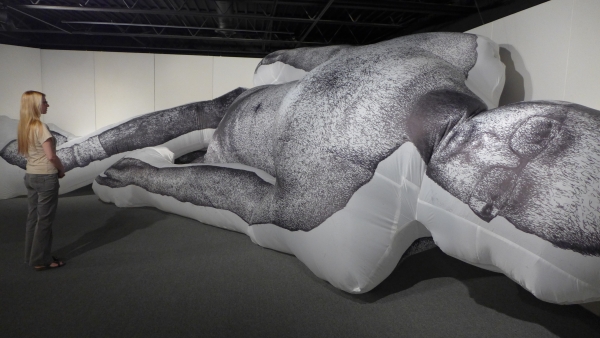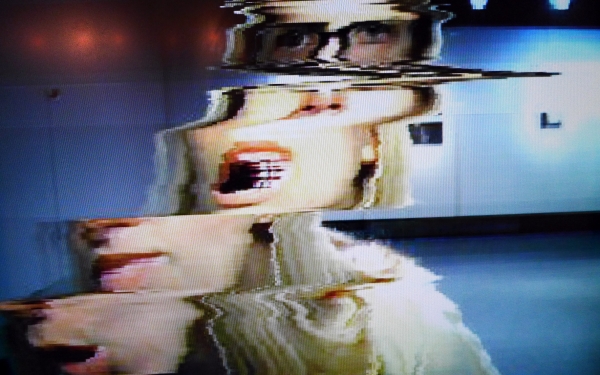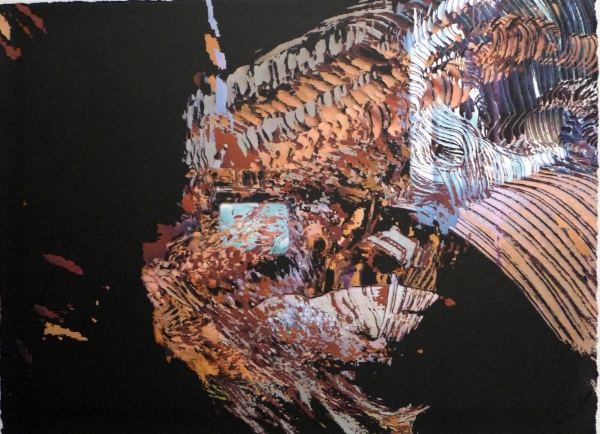Paintings on a wall, sculptures on a pedestal; often a gallery visit includes a formal, passive experience with exhibited artwork. Two new exhibitions at Rosewood Gallery, however, demonstrate the interaction and relationships between a physical space, artwork and the viewer. Evoking playfulness, emotion and wonder, artworks by Benjamin Entner (Oswego, NY) and Steven H. Silberg (Cantonsville, MD), challenge the traditional art gallery with installations that literally push the boundaries of the white walls and the way we interact with art.
 Benjamin Entner, Colossus, 2013
Benjamin Entner, Colossus, 2013
Benjamin Entner’s sculpture Colossus is a larger-than-life self-portrait, drawn with black marker on white fabric. Inflated and three-dimensional, the figure’s feet crush against one gallery wall and his head another. Already floor to ceiling, the sculpture’s unexpected scale is awe-inspiring, as is encountering the subject himself, clad only in socks.
“I want to make viewers aware of themselves as they relate to my art…by creating a presence of an object or installation that interrupts or intervenes in the passive viewing of a piece and invites an active experience with it,” Entner wrote. The artist frequently uses humor in his work to evoke a reaction from the viewer, often through unexpected encounters with a larger-than-life self-portrait. “Within the gravitas of a typical art space, I also try to inspire a childlike nostalgia and wonder by engaging the viewer with an object or environment that is fun, funny, playful, awesome, and/or rad.”
Colossus is a part of Entner’s series of work titled Ego Sum, intended to parody Classical and Renaissance sculpture. The series is based on the massive ‘colossus’ statues of heroes and gods, monuments that could be seen for miles in the landscapes of ancient Greece and Rome. “These ‘sculptural drawings’ are made to the same size and scale to the historical sculptures that they reference,” wrote Entner. “The outcomes are semi-comical adaptations whose amorphous form plays with the definitions of representation and classical beauty.”
“Focusing on the figure, I draw contemporary individuals: myself, friends, family, in postures similar to the figures of Classical Greco-Roman and Renaissance sculpture,” said Entner. “In so doing, I hope to create an awkward dialogue between my contemporary parodies and the historical works—a dialogue that questions and challenges perspectives of beauty, proportion, sexuality, and idealized form.”
Movement and interaction is also essential to the artwork in Steven H. Silberg’s exhibition. Working primarily with the pixel as his medium, Silberg has transformed vernacular pieces of technology into interactive, painterly compositions. In the work Reductive Video, when a viewer enters the gallery, a video camera activates and records movements throughout the space. These movements are translated into layers of color and form on a projection, thrown onto a large gallery wall. The longer the visitor is active in the space, the more complex the composition becomes, capturing layers upon layers of imagery. Sparked by an interest in “exploring the degradation and decay of digital data and media,” Silberg’s installations allow “the viewer to become the chance operation within a rigidly planned system.”
 Steven H. Silberg, Pixel-Lapse Photo Booth: Amy, 2014
Steven H. Silberg, Pixel-Lapse Photo Booth: Amy, 2014
Silberg draws on formal photographic concepts to utilize and subvert technology, but the work can only exist with the participation of the viewer. “As the viewer interacts with my installations, his or her awareness of the process of constructing an image grows,” Silberg wrote. “Whether by emerging as the noise within the system, engaging in the process of degradation, or by witnessing and manipulating the visual matrix as it fills in a rigid and organized fashion, [the viewer is] engaging in the process of construction.”
In the work Pixel-lapse, an antiquated arcade-style video game box documents the subject through a scan-like process, which captures the portrait sitter’s movement, including deliberate actions or subtle activity such as breathing. “Pixel-lapse combines the temporal nature of long exposure photography and the precise organization of the digital matrix,” Silberg wrote. “By creating an image one pixel at a time, each part of the image shows different captured moments. In the end, each image not only has dimension but also gains duration and velocity.”
 Steven H. Silberg, For Love (detail) 2010, Reductive Video Image
Steven H. Silberg, For Love (detail) 2010, Reductive Video Image
Other works include the series For Love, a grid of prints created through the reduction of a video. Through the motion of moving images harvested from video-sharing websites, layers of impressions are flattened into a composition, creating colorful, abstract arrangements.“As we become users of the technology, a disconnect grows between the process and the result. As an image-maker, I choose to take back the process,” Silberg wrote. “My work develops from an interest in exploring the degradation and decay of digital data and media.”
“I am somewhat of a digital literalist – a digital minimalist,” Silberg continued. “The starting point for my work is the medium’s material itself. In most cases, that material is the pixel – that dot on the screen (on all screens) – that becomes something larger. In considering our relation to that digital element, my work develops.”
The work of Benjamin Entner and Steven H. Silberg is on view through May 16, 2014 at Rosewood Gallery. Learn more about the exhibition by visiting gallery.ketteringoh.org, calling (937) 296-0294, or visiting Rosewood Gallery at Rosewood Arts Centre, 2655 Olson Drive, Kettering, OH 45420.
This article was originally published in the April 29, 2014 edition of the Dayton City Paper.
Leave a comment